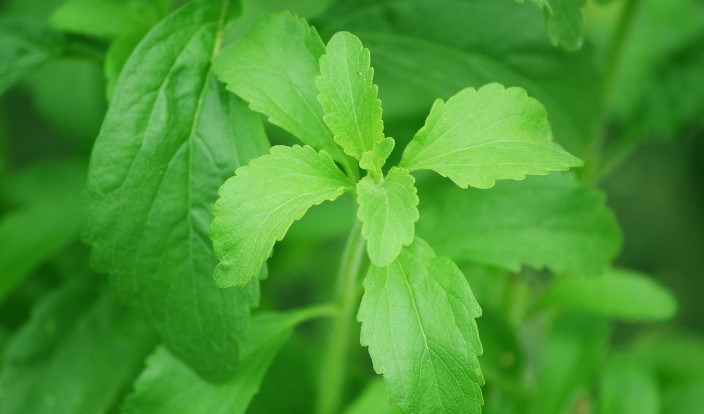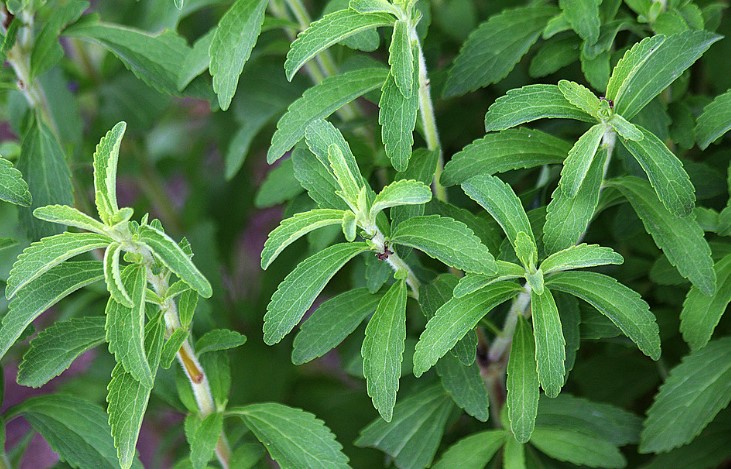Page Contents
Stevia rebaudiana
No plant offers as much sweetness as stevia, and no plant produces as safe a sugar substitute for diabetics as Stevia rebaudiana. Stevia syrup is nothing short of fabulous, unlike the fresh and dried leaves. Stevia flowers are preserved in honey by Brazilian visitors to the Herbal Center gardens as a winter medicine.
The origins of Stevia can be traced to Brazil and Paraguay, where it was known as caa’he or’sweet leaf’, and ancient pharmacopeias describe it as a natural contraceptive. Scientists first discovered stevia in 1887, when two French chemists isolated a glucoside present in the leaves called’steviocide’. Today, the name is still used.
Stevia is 300 times sweeter than sugar, and as it is a natural sweetener and safe for diabetics, it has generated tremendous interest. An extraction technique developed by the Japanese in 1970 removed the chlorophyll and the bitterness from the leaf, producing a white powder now used globally in the food industry.
Stevia powder is chemically processed and may contain anti-caking and whitening agents, so I do not use it. As for the tiny white flower clusters, I prefer to use them naturally—both fresh and dried leaves.
Cultivation
Stevia requires full sun and goes dormant in winter, dying down to almost nothing in some cases. Cover it with some rough compost and dried leaves during the winter months so it won’t be disturbed. The plants need a slow soak three times a week in summer and once a week in winter. Ensure that the hole is deeply dug, richly composted, and flooded with water before planting stevia.
Hole spacing should be 1 meter apart. Propagation is easiest during the spring and early summer, when rooted tufts are gently dug out and replanted into richly composted holes. Until it roots again, keep it moist. Cover seeds lightly with moist soil in seed trays (I use a sieve and sprinkle just enough soil to cover the seeds).
So as not to disturb the fragile seeds, keep the seed tray in a large tray of water so that it remains damp from below. It should not be allowed to dry out for a short time. Seedlings should be pricked out when they are big enough to handle and planted into composted and soil-filled bags as soon as they are big enough. Gradually move them away from the shade and keep them moist. Due to its spindly nature, stevia should be placed carefully in the garden. The self-sown seedlings are often surprising, as I plant them in the kitchen garden and other annuals.

Medical Use
Several studies have found that stevia can help lower high blood pressure, high sugar levels, and high cholesterol levels. Please discuss this with your doctor and do not exchange your present medications for stevia, as this is still under investigation. Commercial toothpaste and mouthwashes contain stevia, which is known to be effective in treating gums, tooth decay, and plaque.
Sore throats, bleeding gums, mouth ulcers, and fever blisters will be soothed by stevia tea made from flowers and buds. Make the tea by pouring one cup of boiling water over 14 cups of flowers, letting it stand for five minutes, then straining and sipping slowly. Lip and nose-cracked skin can be soothed by stevia cream. It stops any cracking or bleeding while fever blisters heal, and it also helps to heal fever blisters.
Gargle with Stevia flower
Mouth ulcers can be treated with this gargle. Making it fresh and using it three times a day is very effective. One cup boiling water, half cup stevia flowers, buds, and leaves ¼ teaspoon powdered clove Pour the boiling water over the flowers, buds, and leaves. Wait 10 minutes for it to cool. The leaves and flowers should be pressed well into the water. Then strain it. Lastly, add the powdered clove and stir well. Take a sip of the liquid and swirl it around in your mouth.
For fever blisters and cracked lips, use stevia flower cream
One cup good aqueous cream, one cup chopped stevia buds, flowers, and few stems two teaspoons vitamin E oil 2 teaspoons grape seed oil Simmer the aqueous cream and stevia in a double boiler for 30 minutes, stirring frequently. After cooling, strain through a fine sieve and add the vitamin E oil and grape seed oil. Apply liberally and often to the area after putting it in a sterilized jar with a tight-fitting lid. As for the blister on my foot, I also found this cream to be excellent.
Culinary Applications
Lemonade with Stevia flower
It’s the perfect sugar-free summer drink! Put the juice of 10 lemons in a large jug, along with 2 cups of stevia flowering sprigs and one liter of water. For 20 minutes, boil the stevia in water. Cover it and let it cool. To the lemon juice, add two cups of the strained stevia tea. You can add more sweetness, a cupful at a time, if you need it. Pour the syrup into a glass bottle and store it in the refrigerator when it is pleasantly sweet. Therefore, to serve, pour ¼ glass of lemon syrup, top up with crumbled ice and water, and taste. If you need more syrup, add it until it’s just right!
COOK’S NOTE
Drinks, desserts, cheesecakes, and syrups can be made with fresh or dried stevia leaves and flowers, or they can be made into a syrup by simmering one cup of fresh buds and flowers in half a liter of cold water for 20 minutes. Keep the syrup covered while it cools. Keep it in a well-corked glass bottle in the refrigerator. As a sweetener, use a little at a time for drinks and desserts.
Stevia flower rice pudding
SERVES four to six for rich and creamy comfort food, this easy dessert has to be it! Add four cups of milk 2 cups Basmati rice ½ cup of finely chopped stevia flowers and buds ¾ cup of sultanas After that, I soaked in hot water for 20 minutes. Also, one cup of thin cream Gently simmer the milk, rice, and stevia on low heat in a heavy-bottomed pot, stirring frequently with a wooden spoon.
As soon as it thickens, stir in the sultanas thoroughly. Alternatively, serve the pudding with a glass of cream poured over it at the table. If you are hosting a celebration lunch or dinner, serve it with strawberries, raspberries, or sliced peaches. In order to thicken the milk and soften the rice, the recipe calls for long, slow cooking.
COOK’S NOTE:
Replace sugar in your favorite recipes with finely chopped stevia flowers, buds, and leaves by halving the sugar. Cook apricots with half a cup of stevia instead of one cup of sugar, simmer together, and taste. Make notes and adjust as necessary!
